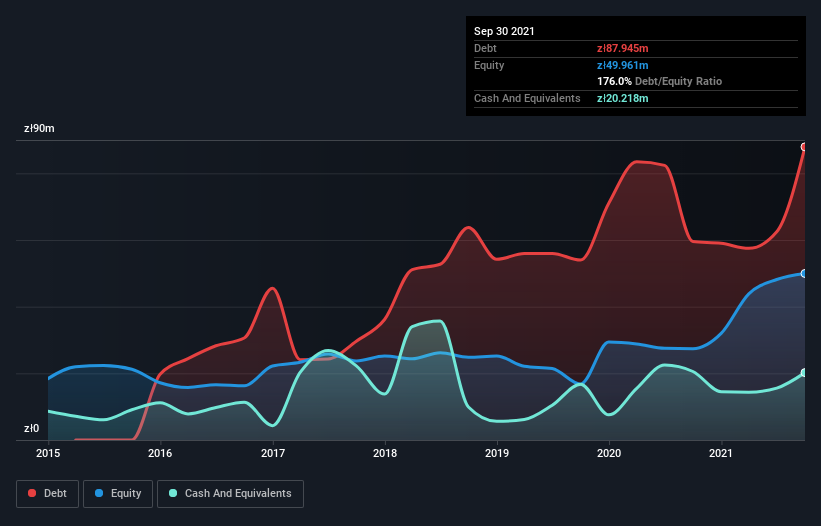David Iben put it well when he said, 'Volatility is not a risk we care about. What we care about is avoiding the permanent loss of capital.' When we think about how risky a company is, we always like to look at its use of debt, since debt overload can lead to ruin. We can see that HM Inwest S.A. (WSE:HMI) does use debt in its business. But should shareholders be worried about its use of debt?
Why Does Debt Bring Risk?
Debt is a tool to help businesses grow, but if a business is incapable of paying off its lenders, then it exists at their mercy. Part and parcel of capitalism is the process of 'creative destruction' where failed businesses are mercilessly liquidated by their bankers. However, a more usual (but still expensive) situation is where a company must dilute shareholders at a cheap share price simply to get debt under control. Of course, the upside of debt is that it often represents cheap capital, especially when it replaces dilution in a company with the ability to reinvest at high rates of return. The first thing to do when considering how much debt a business uses is to look at its cash and debt together.
View our latest analysis for HM Inwest
What Is HM Inwest's Debt?
You can click the graphic below for the historical numbers, but it shows that as of September 2021 HM Inwest had zł87.9m of debt, an increase on zł59.5m, over one year. However, it also had zł20.2m in cash, and so its net debt is zł67.7m.

How Strong Is HM Inwest's Balance Sheet?
Zooming in on the latest balance sheet data, we can see that HM Inwest had liabilities of zł78.4m due within 12 months and liabilities of zł67.0m due beyond that. Offsetting this, it had zł20.2m in cash and zł21.3m in receivables that were due within 12 months. So its liabilities outweigh the sum of its cash and (near-term) receivables by zł103.8m.
This deficit casts a shadow over the zł53.5m company, like a colossus towering over mere mortals. So we definitely think shareholders need to watch this one closely. After all, HM Inwest would likely require a major re-capitalisation if it had to pay its creditors today.
We use two main ratios to inform us about debt levels relative to earnings. The first is net debt divided by earnings before interest, tax, depreciation, and amortization (EBITDA), while the second is how many times its earnings before interest and tax (EBIT) covers its interest expense (or its interest cover, for short). This way, we consider both the absolute quantum of the debt, as well as the interest rates paid on it.
HM Inwest's net debt to EBITDA ratio of about 2.2 suggests only moderate use of debt. And its strong interest cover of 11.7 times, makes us even more comfortable. It is well worth noting that HM Inwest's EBIT shot up like bamboo after rain, gaining 36% in the last twelve months. That'll make it easier to manage its debt. The balance sheet is clearly the area to focus on when you are analysing debt. But it is HM Inwest's earnings that will influence how the balance sheet holds up in the future. So if you're keen to discover more about its earnings, it might be worth checking out this graph of its long term earnings trend.
But our final consideration is also important, because a company cannot pay debt with paper profits; it needs cold hard cash. So we always check how much of that EBIT is translated into free cash flow. In the last two years, HM Inwest created free cash flow amounting to 16% of its EBIT, an uninspiring performance. That limp level of cash conversion undermines its ability to manage and pay down debt.
Our View
While HM Inwest's level of total liabilities has us nervous. To wit both its EBIT growth rate and interest cover were encouraging signs. Taking the abovementioned factors together we do think HM Inwest's debt poses some risks to the business. While that debt can boost returns, we think the company has enough leverage now. There's no doubt that we learn most about debt from the balance sheet. But ultimately, every company can contain risks that exist outside of the balance sheet. For example HM Inwest has 4 warning signs (and 2 which can't be ignored) we think you should know about.
Of course, if you're the type of investor who prefers buying stocks without the burden of debt, then don't hesitate to discover our exclusive list of net cash growth stocks, today.
Valuation is complex, but we're here to simplify it.
Discover if HM Inwest might be undervalued or overvalued with our detailed analysis, featuring fair value estimates, potential risks, dividends, insider trades, and its financial condition.
Access Free AnalysisHave feedback on this article? Concerned about the content? Get in touch with us directly. Alternatively, email editorial-team (at) simplywallst.com.
This article by Simply Wall St is general in nature. We provide commentary based on historical data and analyst forecasts only using an unbiased methodology and our articles are not intended to be financial advice. It does not constitute a recommendation to buy or sell any stock, and does not take account of your objectives, or your financial situation. We aim to bring you long-term focused analysis driven by fundamental data. Note that our analysis may not factor in the latest price-sensitive company announcements or qualitative material. Simply Wall St has no position in any stocks mentioned.
About WSE:HMI
HM Inwest
Engages in the investment, development, and sale of real estate properties in Poland.
Slight with mediocre balance sheet.
Market Insights
Community Narratives



